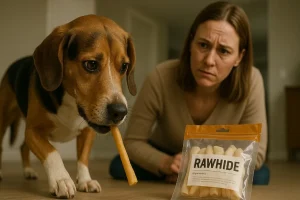Why is rawhide still widely sold in pet stores? Why do many owners believe it’s safe, even though countless warnings exist from veterinarians and pet health organisations? These are important questions that responsible dog owners in the UK must ask themselves.
Rawhide chews have been popular for decades, marketed as a solution for teething puppies, bored pets, and dental hygiene. On the surface, they seem ideal, affordable, widely available, and long-lasting. However, behind this commercial convenience lies a host of health risks that many pet owners are still unaware of.
Rawhide is not food, it is a by-product of the leather industry, heavily processed with chemicals and stripped of any nutritional benefit. When ingested by dogs, it can lead to digestive blockages, choking, chemical exposure, and digestive upset.
With so many vet-recommended, safer alternatives on the market today, it’s essential for dog owners to understand exactly why rawhide is dangerous, and what they can offer their dogs instead.
What Makes Rawhide So Hazardous for Dogs?

Rawhide chews are made from the inner layer of cow or horse hides. Once the hide is removed, it undergoes an extensive process involving washing, bleaching, and chemical treatment to produce the familiar white or brown chew sticks seen on shop shelves.
Unfortunately, while the final product may look clean and harmless, it is anything but.
These chews are not digestible like natural food products. Dogs often gnaw at them until large, soft pieces break off, which are then swallowed.
These chunks do not dissolve easily in the stomach and can become lodged in the oesophagus, stomach, or intestines, potentially causing life-threatening blockages. Even if they pass through, they may cause vomiting, diarrhoea, or internal irritation.
The risks are not only physical. Because rawhide is not regulated as food, its manufacturing process allows for the use of bleach, hydrogen peroxide, glue-based binders, and preservatives, some of which may be toxic if ingested over time. These chemicals can build up in the dog’s system or cause immediate gastrointestinal distress.
Moreover, rawhide offers no real nutritional value. In some cases, manufacturers add flavourings and salt to increase palatability, which may further exacerbate health issues in dogs with dietary restrictions or kidney problems.
How Does Rawhide Cause Digestive Blockages in Dogs?
Unlike food-based treats, rawhide is not designed to be consumed. When a dog chews on rawhide, they often swallow the softened pieces that break off. Because these pieces are not digestible, they can accumulate in the digestive tract, leading to a partial or complete obstruction.
Blockages can occur anywhere from the oesophagus to the intestines. Once stuck, these pieces can cause a range of symptoms including abdominal pain, vomiting, constipation, and loss of appetite. In severe cases, surgery is the only solution to remove the blockage, which comes with its own risks and financial costs.
Dogs that are aggressive chewers, or that tend to gulp down treats without properly chewing them, are especially vulnerable to this issue. However, blockages have been observed in all sizes and breeds, indicating that the problem is not limited to certain types of dogs.
Why Is Choking One of the Most Immediate Risks of Rawhide?

Of all the risks associated with rawhide, choking is among the most urgent and potentially fatal. As dogs chew rawhide, they may bite off large chunks which can become lodged in the back of the throat or windpipe.
If this happens, the dog may be unable to breathe, and without immediate intervention, the situation can quickly turn fatal.
In many cases, dogs choke while their owners are unaware, especially if left alone with rawhide. The lack of supervision combined with the unpredictable nature of how rawhide breaks apart makes it an extremely risky treat.
Even if a dog is not completely choking, partial obstruction can still cause distress, coughing, retching, and potential injury to the throat or oesophagus.
Can Rawhide Upset a Dog’s Digestive System?
Yes rawhide can cause significant digestive upset, even when it doesn’t lead to a full blockage or choking incident. The indigestible fibres in rawhide can irritate the stomach lining or cause food to move improperly through the digestive system.
Dogs may experience:
- Diarrhoea
- Nausea
- Bloating
- Excessive gas
- Lethargy after chewing rawhide
These symptoms are especially common in dogs with sensitive stomachs or those that already suffer from gastrointestinal issues. Even healthy dogs can develop these problems when rawhide is consumed regularly or in large quantities.
What Harmful Chemicals Are Used in Rawhide Processing?
The transformation of rawhide from animal hide to a chewable product is a complex, industrial process involving multiple chemical stages. These chemicals are not only unregulated but also potentially harmful if ingested by your dog.
Common chemicals found in rawhide production include:
| Chemical | Purpose | Potential Risk |
| Bleach or Hydrogen Peroxide | Whitening and disinfecting | Chemical burns or gastrointestinal irritation |
| Formaldehyde | Preservative | Toxic to dogs; banned in many countries for food use |
| Sodium Sulphide | Removes hair from hides | Can be corrosive and toxic |
| Artificial Flavours & Dyes | Increase palatability | May trigger allergies or long-term health effects |
Because these products are not classified as food, manufacturers are not required to disclose the chemical treatments used, leaving consumers in the dark about what their pets are really consuming.
Does Rawhide Provide Any Nutritional Benefits to Dogs?

Despite being labelled as a treat, rawhide provides virtually no nutritional benefit. It is not a source of healthy protein, vitamins, or minerals. In fact, some rawhide products may contain excessive salt or added protein, which can be harmful to dogs on restricted diets or with kidney or liver conditions.
Pet owners looking for functional treats that support dental hygiene, joint health, or coat quality are better off choosing products specifically formulated for these purposes.
What Are the Best Alternatives to Rawhide Chews?
With rising awareness about the dangers of rawhide, pet owners now have access to a growing range of safer, vet-approved alternatives. These products not only satisfy the chewing instinct but also contribute to your dog’s health and well-being.
Examples of healthy rawhide alternatives include:
- Bully Sticks: Made from dried beef muscle, they are more digestible and less likely to cause obstruction. They come in various sizes and are generally free of additives.
- Dental Chews: Designed to reduce tartar and plaque, many are shaped and formulated to be easily digestible and beneficial to oral health.
- Natural Vegetable Chews: Products made from sweet potato or other vegetable bases offer a vegetarian option that is high in fibre and gentle on the stomach.
- Rubber Chew Toys: Toys made from food-safe rubber can provide mental stimulation and physical satisfaction, especially when filled with treats.
Comparison Table: Rawhide vs Safe Alternatives
| Feature | Rawhide | Bully Sticks | Dental Chews | Rubber Toys |
| Digestibility | Poor | Good | Excellent | N/A |
| Choking Risk | High | Low | Low | Very Low |
| Nutritional Value | None | High | Moderate | None |
| Chemical Additives | Often Present | Rare | Rare | None |
| Vet Recommended | Rarely | Often | Frequently | Frequently |
These alternatives can be found at most UK pet stores or reputable online retailers. Look for products that are 100% natural, made in the UK or EU, and labelled “rawhide-free.”
How Can Pet Owners Ensure Safer Chewing Practices?

Regardless of the treat or toy given, chewing always carries some level of risk. The key is to adopt safe habits and choose products carefully.
Always supervise your dog while they’re chewing, particularly with edible treats. Remove and dispose of any chew that becomes small enough to swallow.
Pay attention to your dog’s chewing habits if they are an aggressive chewer or prone to swallowing pieces whole, opt for durable rubber toys over digestible treats.
Finally, speak to your vet about what’s best for your dog based on their age, size, health history, and dietary needs. Customised advice is always more reliable than general guidelines.
Why Should Rawhide Be Avoided Completely?
The evidence against rawhide is clear. It poses serious health risks without offering any nutritional or developmental benefits.
From chemical contamination to digestive blockages, the dangers outweigh any perceived advantages. With so many safer, healthier, and equally satisfying alternatives available, there is no compelling reason to continue offering rawhide to your pet.
As responsible dog owners, it is our job to make informed decisions that prioritise our dogs’ safety and wellbeing. Eliminating rawhide from your dog’s routine is one such decision that can have immediate and long-term benefits.
FAQs About Rawhide and Safer Chew Options
Are some rawhide brands safer than others?
While some brands claim to use fewer chemicals or better processing methods, the risks of choking, blockage, and lack of nutrition still apply. Most vets recommend avoiding rawhide altogether.
What should I do if my dog swallows a large piece of rawhide?
Contact your vet immediately. Even if your dog seems fine at first, symptoms like vomiting, bloating, or lethargy can appear hours later and may indicate a serious issue.
Are rawhide chews suitable for large breeds?
Larger dogs may seem less vulnerable, but they are often stronger chewers and more capable of swallowing dangerous chunks. The size of the dog doesn’t eliminate the risk.
Can puppies chew rawhide?
Puppies should never be given rawhide. Their digestive systems are more sensitive, and their smaller throats increase the risk of choking.
Are dental sticks a better option?
Yes. Dental sticks are formulated to be safe, digestible, and effective at reducing plaque. Many UK vets recommend brands like Lily’s Kitchen or Whimzees.
How often should I give my dog a chew?
It depends on the type. Natural chews can be given a few times per week, while rubber toys can be used daily. Always supervise and adjust based on your dog’s chewing style.
How can I tell if a chew is truly rawhide-free?
Check the ingredients and packaging. Look for phrases like “100% natural”, “rawhide-free”, and “fully digestible.” If in doubt, ask your vet or stick to trusted UK brands.






